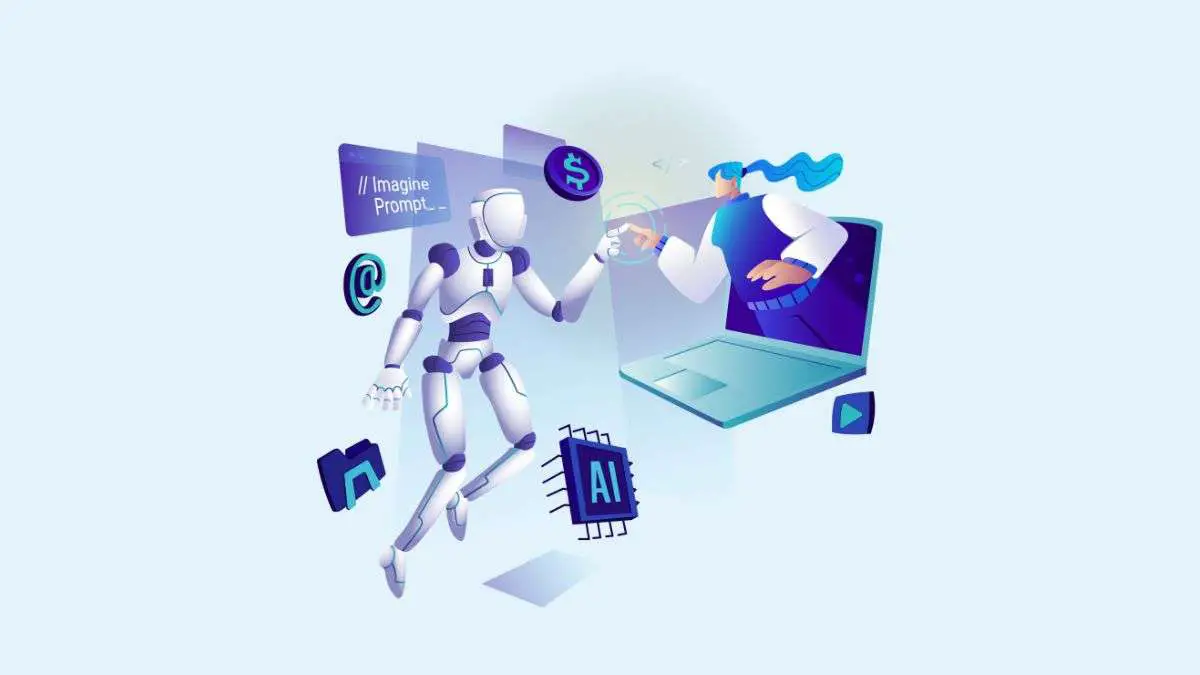Table of Contents
- Introduction
- The Role of AI in Publishing
- Challenges Posed by AI in Publishing
- Opportunities for Innovation through AI in Publishing
- Is AI a Threat to Publishing? Assessing the Details
- Conclusion
Introduction
A prevalent question in the age of artificial intelligence (AI): Is AI a threat to publishing?
AI is profoundly transforming the publishing industry. From content creation to distribution, AI tools and algorithms enhance efficiency, personalize recommendations, and provide valuable data insights. However, the rise of AI also poses concerns and risks about its potential impact on jobs, ethics, and content quality.
As publishers grapple with leveraging AI’s advantages while mitigating risks, critical questions emerge about AI’s opportunities, threats, and future in publishing.
AI involves a computer system performing tasks normally requiring human intelligence, such as visual perception, speech recognition, and decision-making. In publishing, AI is being applied across multiple functions:
- Automated writing tools can generate draft articles, reports, and other content
- Natural language processing algorithms power manuscript screening, copy editing, and proofreading
- Chatbots provide customized book recommendations and respond to customer inquiries
- Data mining of readership metrics informs publishing strategies and investments
As these use cases demonstrate, AI has permeated virtually every link in the publishing chain – from ideation to production to promotion and sales.
The Impact of AI on the Publishing Industry
Understanding AI’s emerging role is crucial for publishers seeking to harness its upside while safeguarding against potential downsides. Key questions include:
- How can publishers utilize AI ethically and effectively?
- What jobs may be at risk as AI takes on more responsibilities?
- Could reliance on algorithms perpetuate biases or reduce content diversity?
- How can publishers reskill workforces to complement AI rather than compete with it?
This analysis aims to spur meaningful debate around these issues and provide recommendations for publishers looking to adopt AI. The stakes are high, but so too is the potential to transform publishing in groundbreaking ways.
Consider this startling projection – by 2030, AI could produce up to 90% of all digital content online. This seismic shift prompts urgent questions:
- What becomes of creativity and authenticity in publishing as AI proliferates?
- Are we ceding too much control over content to algorithms optimized for clicks rather than quality or social good?
This write-up delves into the perils and promise of the AI revolution in publishing. The path forward requires embracing innovation while upholding the humanistic values of publishing.
The Role of AI in Publishing
AI is transforming various aspects of the publishing industry. From content creation to distribution, publishers use AI tools to enhance efficiency and reduce costs.
Automated Content Creation
AI algorithms can generate content for publishers based on data inputs and guidelines. This includes writing first drafts of articles, short-form content for social media, and even fiction stories. For example, The Washington Post uses an AI writing assistant called Heliograf to create news stories with basic facts and quotes, allowing journalists to focus on more complex reporting.
Streamlined Editing and Fact-checking
AI tools are assisting publishers with editing and fact-checking content. The software can check for grammar, spelling, and style errors. In articles, it can also flag potential issues with facts, dates, names, and statistics. For instance, Forbes uses an AI proofreading tool, Grammarly, to enhance editing. Factmata also offers an AI fact-checking platform to verify claims.
Personalized Recommendations
Sophisticated AI algorithms analyze customer data to provide each reader with personalized ebook, audiobook, and newsletter recommendations. This allows publishers to improve customer retention. For example, online book retailer BookBub uses AI to study readers’ preferences and recommend relevant books from various publishers.
In summary, AI is transforming publishing by automating rote tasks. This lets publishers focus resources on high-value activities. When thoughtfully implemented, AI tools can empower publishers to boost efficiency, engage readers, and make data-driven decisions.
Challenges Posed by AI in Publishing
As AI capabilities advance, there are growing concerns that AI tools could replace human jobs in publishing. AI is already being used to automate certain tasks like proofreading, fact-checking, and content recommendations. While this improves efficiency, it risks displacing editors, writers, and other publishing professionals. We must thoughtfully implement AI to augment human skills rather than fully replace them. Publishers should provide training and support to help their workforce adapt to working alongside AI.
Potential Issues Related to AI-generated Content
The rise of AI-generated text, audio, and visual content raises ethical questions about authenticity and quality. AI-generated content and literature lack the creativity, nuance, and care human creators bring. Over-reliance on synthetic content could erode publishing quality standards and trust.
Clear AI content policies are needed to disclose the use of AI, uphold accuracy, correct errors, and prevent plagiarism or copyright issues with AI-generated content. While AI tools can enhance content relevance and personalization, upholding ethical principles must remain the priority.
If not developed conscientiously, AI algorithms can perpetuate and amplify societal biases around race, gender, or other attributes. Biased data used to train AI models leads to biased outputs. For example, AI writing tools may produce racist or sexist content without proper mitigation. To uphold diversity and inclusion, publishers must audit their AI systems for prejudice, use representative data, and continually assess algorithmic fairness.
AI governance in publishing should involve diverse experts and community perspectives to identify potential harms early. The goal of responsible AI implementation is to respect human dignity.
Opportunities for Innovation through AI in Publishing
AI presents exciting opportunities for innovation in the publishing industry. Publishers can leverage AI to revolutionize content recommendations for readers. By analyzing user data and content, AI algorithms can deliver ultra-personalized recommendations. This helps connect readers with content they love while promoting the discovery of new authors and titles. Additionally, AI tools can streamline editorial workflows.
Fact-checking, Copyediting, and Proofreading
This frees editors to focus on providing authors with strategic guidance. It also reduces costs associated with the editing process. With streamlined workflows, publishers can accelerate time-to-market for new product releases.
Audience Insights
Publishers gain an information advantage by processing reader data, interests, and content engagement. These insights inform strategic decisions like which authors and genres to acquire or which formats and channels to publish. Publishers can also use AI to identify market gaps and opportunities.
AI introduces new potential in areas like ultra-personalization, efficiency through automation, and data-driven decision-making. While AI does pose some challenges, an opportunity exists for innovation that benefits both publishers and readers. Adopting AI thoughtfully and ethically paves the way for continued evolution in the publishing landscape.
Is AI a Threat to Publishing? Assessing the Details
The discussion about AI’s impact on publishing encompasses issues such as authorship, copyright, and the distribution of information. The dynamic nature of the publishing world and its ongoing adaptation to digital technologies set the stage for integrating AI systems.
When evaluating AI’s potential threat to publishing, several dimensions must be considered. First, let’s look at the current landscape of publishing. Historically, publishing has acted as a gatekeeper for quality, ensuring that content meets certain standards before it is disseminated to the public. Digital platforms have shifted this dynamic, allowing more content creators to bypass traditional publishing routes.
In the context of AI, we need to examine how AI-generated content could alter the market for human-created content. There are concerns regarding the sheer volume of content AI could produce, potentially overwhelming human authors. On top of this, the capability of AI to generate written content that is increasingly indistinguishable from that produced by humans brings challenges and opportunities.
One key concern is the issue of attribution and plagiarism. With AI, there’s the possibility of generating content that closely mimics existing authors’ styles or producing large volumes of derivative works. Such activities could undermine the rights of original content creators and dilute their opportunities to monetize their work.
Another consideration is the role of AI in facilitating new forms of publishing. Algorithmic curation and recommendation systems already play a major role in what content reaches readers through platforms such as news aggregators, social media feeds, and online book retailers. AI could further personalize reading experiences, potentially increasing reader engagement and shaping the market demand in ways that may not prioritize traditionally published content.
Moreover, AI-powered tools can assist in content creation and editing, leading to faster production times and potentially reducing costs. While this can democratize content creation, it may also lead to an oversaturated market, which can impact the economic viability of the publishing sector, particularly for individual authors or smaller publishing houses.
Despite these potential threats, it’s also crucial to recognize areas where AI can be beneficial. It can uncover new insights through data analysis, predict market trends for published content, offer personalized content recommendations, and even assist in discovering new talent.

To assess the overall threat, we must balance the economic and creative implications for authors and publishers against AI’s democratizing and efficiency-enhancing capabilities. AI’s impact on publishing is neither wholly negative nor wholly positive. It depends on how stakeholders in the publishing industry adapt to these technologies, establish ethical guidelines, and set forth regulations that ensure a fair playing field for both human and AI contributors. Collaboration between humans and AI could be the key to harnessing the potential of these advancements while mitigating the risks they pose.
Conclusion
In summary, AI is profoundly impacting and fast transforming the publishing industry. From content creation to distribution, AI tools enhance efficiency, reduce costs, and provide valuable insights. However, there are concerns about potential job losses and ethical issues regarding biased or low-quality AI-generated content.
Moving forward, the ideal approach is to thoughtfully leverage the advantages of AI while establishing guidelines to uphold quality and ethical standards. Publishers should continuously evaluate AI systems to ensure they align with core values around diversity and inclusion.
Key summaries of the write-up:
- AI is transforming publishing through automated content creation, data analytics, distribution platforms, and more
- Benefits include enhanced efficiency, lower costs, and valuable audience insights from data
- Risks involve job losses, quality issues, and perpetuating biases in publishing
- A balanced approach can optimize AI’s advantages while managing its downsides
- Readers should stay informed as technology continues advancing rapidly
As consumers, we must stay informed about new advancements in AI and encourage transparency from publishers on how this technology is applied. Responsible development and adoption of AI offer tremendous opportunities for innovation to better serve readers’ evolving interests and make content more accessible worldwide.
However, achieving this vision requires an ongoing, nuanced public dialogue around emerging issues. Policymakers, technology leaders, and publishers must collaborate closely to develop appropriate regulations for our rapidly changing information ecosystem.
